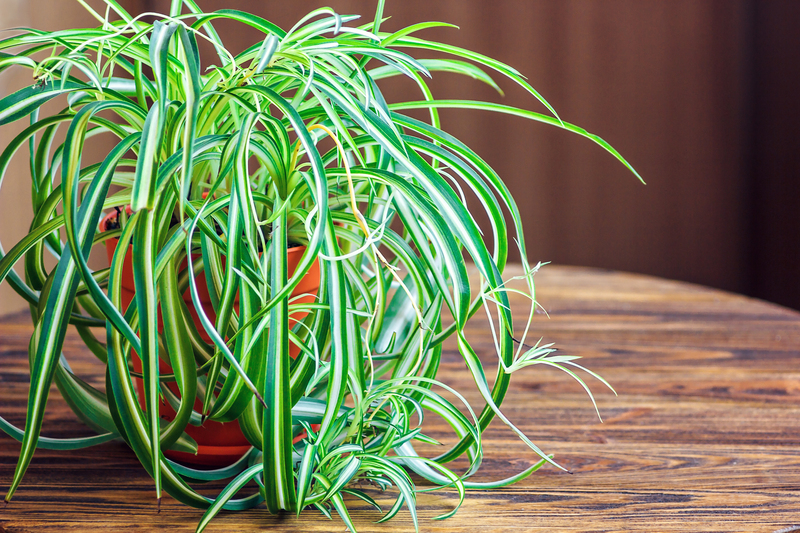Safeguard Your Garden from Winter's Chill
Posted on 05/06/2025
Safeguard Your Garden from Winter's Chill: Essential Strategies for Every Gardener
As the gentle warmth of autumn gives way to the biting winds of winter, every gardener faces a crucial question: How can you best safeguard your garden from winter's chill? Protecting your plants, soil, and garden features during the colder months ensures that your outdoor oasis will emerge vibrant and strong in springtime. In this comprehensive guide, we'll explore a variety of methods and winter garden protection tips to help shield your cherished green space from the harsh realities of winter.

Why Is Winter Protection for Gardens Important?
Winter poses a unique set of challenges for gardens. Frost, snow, freezing rain, and fluctuating temperatures can all inflict lasting damage on plants, soil, and even hardscaping elements. Safeguarding your garden from winter's chill doesn't just preserve its beauty; it protects your investment of time, money, and effort.
- Prevent plant loss from frost, freezing, and desiccation.
- Preserve soil health by preventing erosion and nutrient leaching.
- Reduce the need for expensive replacements after winter.
- Support local wildlife by maintaining shelter and food sources.
Understanding the Risks: What Can Winter Do to Your Garden?
Winter in many regions brings more than just cold. Constant freeze-thaw cycles, biting winds, heavy snow loads, and diminished sunlight can have varied effects, including:
- Frost Heave -- Repeated freezing and thawing can push plant roots out of the ground.
- Root Damage -- Prolonged freezing temperatures can kill delicate roots, especially in shallow-rooted plants.
- Desiccation (Drying Out) -- Evergreen leaves and needles can lose moisture faster than roots can absorb, especially in wind.
- Broken Branches -- Ice and snow accumulation may snap weighted branches.
- Soil Erosion -- Bare soil is vulnerable to being washed away by meltwater.
By understanding these winter threats, you can choose the right strategies to safeguard your outdoor space.
Preparing Your Garden for Winter: Step-by-Step Guide
1. Clean Up and Remove Debris
Begin with a thorough garden clean-up. Remove fallen leaves, spent annuals, and rotting fruit or vegetables to reduce disease pressures. While it's essential to clear unwanted debris, consider leaving some undisturbed piles in corners as winter habitats for beneficial insects and wildlife.
2. Mulch for Insulation
Mulching is one of the most effective steps for protecting garden beds from winter's chill. It acts as a temperature buffer for the soil, reducing frost penetration and moisture loss.
- Apply a 2-4 inch layer of organic mulch, such as shredded bark, straw, or compost, over plant roots and bare soil.
- Mulch after the first hard frost for perennials, to prevent rodents from nesting.
- Leave a gap around the base of woody stems to discourage rot.
3. Give Plants a Last Drink
Before the soil freezes, deeply water trees, shrubs, and evergreens. Winter drought is a leading cause of plant death. Well-hydrated soil retains more heat, offering additional root protection.
4. Prune with Purpose
Prune dead, damaged, or diseased branches from trees and shrubs in late autumn. Removing weak limbs decreases the risk of breakage from snow and ice.
- Do not heavily prune live wood in late fall--this can stimulate new growth vulnerable to winter injury.
- Use clean, sharp tools to prevent the spread of disease.
5. Protect Tender Plants
Some plants are more sensitive to frost and cold. Consider these protections for delicate varieties:
- Cloches or homemade covers made from plastic bottles.
- Fleece, burlap, or frost blankets for rows of seedlings or bedding plants.
- Move container plants indoors or group them together in a sheltered spot.
6. Winter-Proof Your Containers
Container plants are highly susceptible to freezing, since their roots are elevated above ground level. To shield your potted plants from winter's chills:
- Wrap pots with bubble wrap or hessian for insulation.
- Elevate containers off the ground to prevent water logging and root rot.
- Move pots close to the house or into sheds/garages for extra warmth.
7. Maintain Lawn Health
Your lawn also needs attention before winter sets in. Mow one final time, set the blade higher, and remove fallen leaves so grass can breathe. Feed with a potassium-rich fertilizer to boost resilience against the cold.
8. Take Care of Wildlife
Winter is tough on birds and beneficial insects. Leave seed heads on some perennials, keep a section of your garden less tidy, and provide bird feeders and water sources. Bat boxes and insect hotels can give shelter to non-hibernating species through winter's chill.
Advanced Winter Protection Strategies
Building Windbreaks and Barriers
Winter winds can drastically lower temperatures and moisture levels in your garden. Setting up windbreaks--temporary fences, burlap screens, or even a line of evergreen boughs--can reduce wind exposure for sensitive plants and structures.
Using Cold Frames and Row Covers
Cold frames and row covers are excellent solutions for protecting young vegetables and herbs, extending the growing season well into winter.
- Cold frames: Simple wooden boxes with glass/plastic lids that trap heat around your plants.
- Row covers: Lightweight fabric draped over hoops, shielding beds from frost and wind.
Protecting Trees and Shrubs from Frost Cracks and Sunscald
On sunny winter days, bark can heat up and then freeze rapidly at night, causing cracks and injury. To safeguard your trees:
- Wrap trunks with tree wrap or flexible spiral guards from late autumn to early spring.
- Whitewashing trunks reflects sunlight and minimizes temperature fluctuations.
Preventing Snow and Ice Damage
After heavy snowfalls, gently brush snow from branches upward (never downward, which can cause breakage). Trim back limbs that overhang walkways or structures to avoid storm damage.
Essential Tools and Supplies for Winter Garden Protection
Having the right tools and materials on hand will make your winter garden safeguarding efforts easier and more effective. Consider stocking up on:
- Mulch (wood chips, straw, or compost)
- Frost blankets, horticultural fleece, or burlap
- Cold frames or hoop tunnels
- Tree wraps and trunk guards
- Quality pruning shears
- De-icing salts harmless to plants (such as calcium magnesium acetate)
- Bird feeders, insect hotels, and nesting boxes
- Weatherproof labels to mark overwintering perennials
What to Avoid: Common Mistakes When Protecting Gardens in Winter
- Over-mulching: Too thick a mulch layer can encourage rot and pest infestations.
- Pruning at the wrong time: Pruning too early or too much can expose plants to winter stress.
- Failing to water dry soil before freezing: Dry root systems are more likely to die in winter.
- Forgetting about containers: Potted plants often need extra insulation or to be brought inside.
- Using harsh chemical salts for de-icing paths near valuable plants.
The Benefits of Winter Garden Safeguarding: Long-Term Rewards
When you protect your garden from winter weather, the benefits extend not just into the next spring, but for many years to come. Some of the key rewards include:
- Healthier and more abundant spring growth
- Improved soil structure and fertility
- Reduced incidence of winter-related plant diseases and injuries
- Increased success with borderline-hardy plant choices
- More sustainable and eco-friendly gardening practices

Frequently Asked Questions: Winter Protection for Gardens
Q: When should I start preparing my garden for winter?
Begin your preparations when nighttime temperatures consistently dip below 45?F (7?C) and before the first hard frost. This window allows you to mulch, cover plants, and finish pruning in time.
Q: How do I protect my vegetable garden from winter?
Use cold frames, floating row covers, and thick mulch to insulate root crops and hardy greens. Harvest tender vegetables before the first freeze, and compost seasonal leftovers.
Q: Is it necessary to protect dormant perennials?
Yes--mulching dormant perennials stabilizes soil temperatures and prevents frost heave. Some perennials also benefit from a light covering of straw or evergreen boughs over crowns.
Q: Can I use plastic sheets for covering plants?
While plastic offers temporary frost protection, it can trap moisture and cause fungal issues. If using, ensure it doesn't touch leaves directly and remove during the day to allow air flow.
Conclusion: Embrace Winter, Protect Your Garden
The transition into winter doesn't have to spell doom for your cherished garden. By incorporating these winter garden safeguarding strategies, you'll not only help your plants survive winter's chill, but ensure a flourishing, beautiful landscape when the warmth returns. Remember: preparation is key, and every effort you make now means less work and greater rewards come spring. Safeguard your garden from winter's chill today--your future self (and your plants) will thank you!
For more seasonal gardening advice and inspiration, explore our blog or join our gardening community to share tips, questions, and your own success stories!

